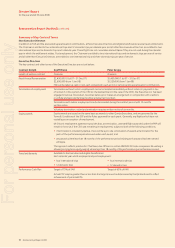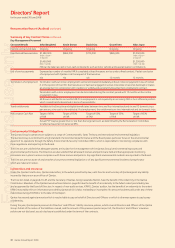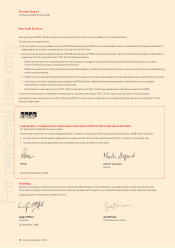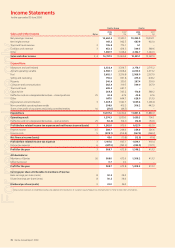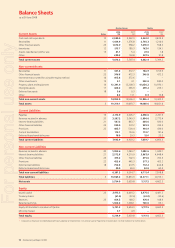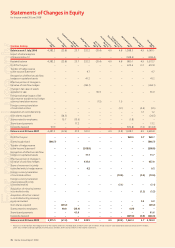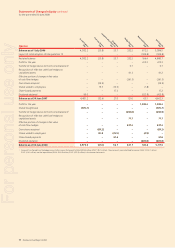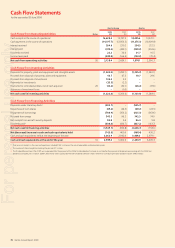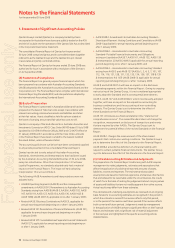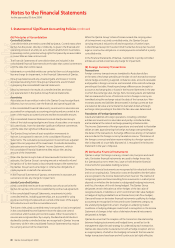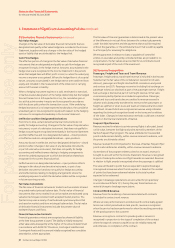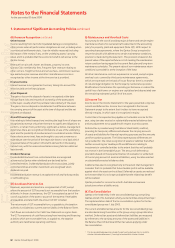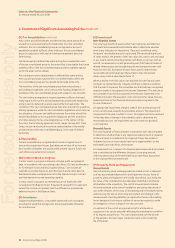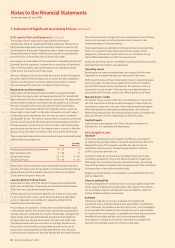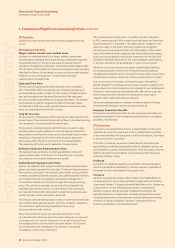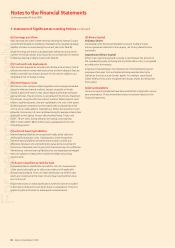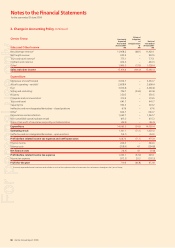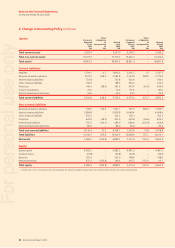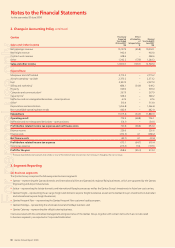Qantas 2008 Annual Report Download - page 82
Download and view the complete annual report
Please find page 82 of the 2008 Qantas annual report below. You can navigate through the pages in the report by either clicking on the pages listed below, or by using the keyword search tool below to find specific information within the annual report.
80 Qantas Annual Report 2008
(D) Principles of Consolidation
Controlled Entities
Controlled entities are entities controlled by Qantas. Control exists when
Qantas has the power, directly or indirectly, to govern the fi nancial and
operating policies of an entity so as to obtain benefi ts from its activities.
In assessing control, potential voting rights that presently are exercisable
or convertible are taken into account.
The Financial Statements of controlled entities are included in the
consolidated Financial Statements from the date that control commences
until the date that control ceases.
Investments in controlled entities are carried at their cost of acquisition,
less any charge for impairment, in the Financial Statements of Qantas.
Intra-group balances and any unrealised gains and losses or income
and expenses arising from intra-group transactions are eliminated
in preparing the consolidated Financial Statements.
Minority interests in the results of controlled entities are shown
as a separate item in the Qantas Group Financial Statements.
Associates
Associates are those entities in which the Qantas Group has signifi cant
infl uence, but not control, over the fi nancial and operating policies.
In the consolidated Financial Statements, investments in associates are
accounted for using equity accounting principles and are carried at the
lower of the equity accounted amount and the recoverable amount.
The consolidated Financial Statements include the Qantas Group’s
share of the total recognised gains and losses of associates on an equity
accounted basis, from the date that signifi cant infl uence commences
until the date that signifi cant infl uence ceases.
The Qantas Group’s share of post-acquisition movements in
reserves is recognised in reserves in the consolidated Financial
Statements. The cumulative post-acquisition movements are adjusted
against the carrying value of the investment. Dividends declared by
associates are recognised in Qantas’ Income Statement, while in
the consolidated Financial Statements they reduce the carrying
amount of the investment.
When the Qantas Group’s share of losses exceeds its interest in an
associate, the Qantas Group’s carrying amount is reduced to nil and
recognition of further losses is discontinued except to the extent that
the Qantas Group has incurred legal or constructive obligations or
made payments on behalf of an associate.
In the Financial Statements of Qantas, investments in associates are
carried at cost less any charge for impairment.
Jointly Controlled Entities
Jointly controlled entities are those entities over whose activities the
Qantas Group has joint control, established by contractual agreement.
In the consolidated Financial Statements, investments in jointly
controlled entities, including partnerships, are accounted for using
equity accounting principles and are carried at the lower of the equity
accounted amount and the recoverable amount.
The share of the jointly controlled entity’s net profi t or loss is recognised
in the consolidated Income Statement from the date joint control
commences until the date joint control ceases. Other movements in
reserves are recognised directly in equity. Dividends and distributions
declared by jointly controlled entities are recognised in Qantas’ Income
Statement, while in the consolidated Financial Statements they reduce
the carrying amount of the investment.
When the Qantas Group’s share of losses exceeds the carrying value
of its investment in a jointly controlled entity, the Qantas Group’s
carrying amount is reduced to nil and recognition of further losses
is discontinued except to the extent that the Qantas Group has incurred
legal or constructive obligations or made payments on behalf of a jointly
controlled entity.
In the Financial Statements of Qantas, investments in jointly controlled
entities are carried at cost less any charge for impairment.
(E) Foreign Currency Transactions
Transactions
Foreign currency transactions are translated to Australian dollars
at the rates of exchange prevailing at the date of each transaction except
where hedge accounting is applied. At balance date, amounts receivable
and payable in foreign currencies are translated at the rates of exchange
prevailing at that date. Resulting exchange differences are brought to
account as exchange gains or losses in the Income Statement in the year
in which the exchange rates change. Non-monetary assets and liabilities
that are measured in terms of historical cost in a foreign currency are
translated using the exchange rate at the date of the transaction. Non-
monetary assets and liabilities denominated in foreign currencies that
are stated at fair value are translated to Australian dollars at foreign
exchange rates prevailing at the dates the fair value was determined.
Translation of Foreign Operations
Assets and liabilities of foreign operations, including controlled
entities and investments in associates and jointly controlled entities,
are translated at the rates of exchange prevailing at balance date.
The Income Statements of foreign operations are translated to Australian
dollars at rates approximating the foreign exchange rates prevailing at
the dates of the transactions. Exchange differences arising on translation
are recorded in the foreign currency translation reserve. The balance of
the foreign currency translation reserve relating to a foreign operation
that is disposed of, or partially disposed of, is recognised in the Income
Statement in the year of disposal.
(F) Derivative Financial Instruments
Qantas is subject to foreign currency, interest rate, fuel price and credit
risks. Derivative fi nancial instruments are used to hedge these risks.
It is Qantas policy not to enter into, issue or hold derivative fi nancial
instruments for speculative trading purposes.
Derivative fi nancial instruments are recognised at fair value both initially
and on an ongoing basis. Transaction costs attributable to the derivative
are recognised in the Income Statement when incurred. The method of
recognising gains and losses resulting from movements in market prices
depends on whether the derivative is a designated hedging instrument,
and if so, the nature of the risk being hedged. The Qantas Group
designates certain derivatives as either hedges of the fair value of
recognised assets or liabilities or a fi rm commitment (fair value hedges);
or hedges of highly probable forecast transactions (cash fl ow hedges).
Gains and losses on derivative fi nancial instruments qualifying for hedge
accounting are recognised in the same Income Statement category as
the underlying hedged instrument. Changes in underlying market
conditions or hedging strategies could result in recognition in the Income
Statement of changes in fair value of derivative fi nancial instruments
designated as hedges.
Qantas documents at the inception of the transaction the relationship
between hedging instruments and hedged items, as well as its risk
management objective and strategy for undertaking each transaction.
Qantas also documents its assessment, both at hedge inception and on
an ongoing basis, of whether the hedging instruments that are used in
hedge transactions have been and will continue to be highly effective.
Notes to the Financial Statements
for the year ended 30 June 2008
1. Statement of Significant Accounting Policies continued
For personal use only



